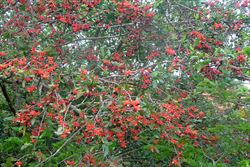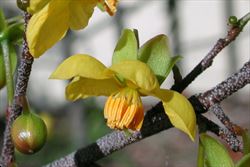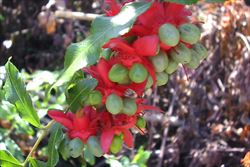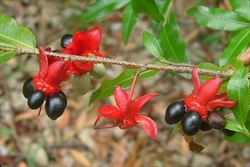Click on images to enlarge

infestation (Photo: Sheldon Navie)

habit (Photo: Sheldon Navie)

habit in fruit (Photo: Sheldon Navie)

leaves (Photo: Sheldon Navie)

flowers (Photo: Sheldon Navie)

close-up of stems, covered in tiny white spots, and flower with reflexed sepals (Photo: Sheldon Navie)

the sepals and base of the flower turn bright red after the petals are shed (Photo: Sheldon Navie)

green immature fruit (Photo: Sheldon Navie)

black mature fruit (Photo: Sheldon Navie)

young plant (Photo: Sheldon Navie)

the very similar Ochna kirkii, with larger and broader leaves, which has yet to become naturalised in Australia (Photo: Sheldon Navie)
Scientific Name
Ochna serrulata (Hochst.) Walp.
Synonyms
Diporidium serrulatum Hochst.
Family
Ochnaceae
Common Names
bird's eye bush, bird's-eye bush, carnival bush, ochna, Mickey Mouse plant, Mickey Mouse bush, small-leaved plane
Origin
Native to southern Africa (i.e. South Africa, Lesotho and Swaziland).
Cultivation
Ochna (Ochna serrulata) was introduced as a garden plant, and is often planted as a hedge. It is still commonly seen growing in older gardens in eastern Australia.
Naturalised Distribution
This species is widely naturalised in eastern Australia. It is most common in the coastal districts of southern and central Queensland, but is also becoming relatively common in the coastal districts of northern and central New South Wales. It was also recently recorded from northern Queensland, and is naturalised on Lord Howe Island and Norfolk Island.
Habitat
Mainly a weed of sub-tropical regions, but also found growing in warmer temperate and tropical environments. This species has invaded roadsides, disturbed sites, waste areas, rainforests, forest margins, riparian areas and dry sclerophyll forests that are close to habitation.
Habit
A small long-lived (i.e. perennial) shrub with an upright (i.e. erect) habit. It usually grows 1-2 m tall, but occasionally reaches up to 3 m in height.
Distinguishing Features
- a small woody shrub with rough pimply-textured bark.
- its alternately arranged leaves are narrowly oval or elongated and have finely toothed margins.
- its bright yellow flowers (2-3 cm across) have five petals, five sepals and numerous stamens.
- the sepals are initially green, but they turn bright red as the fruit develop.
- the small fruit (5-8 mm long) turn from green to black as they mature.
Stems and Leaves
The woody branches are rough in texture and densely covered in many tiny lumps (i.e. lenticels). Younger stems are green to bronze in colour, but turn brown with age.
The alternately arranged leaves are narrowly oval (i.e. elliptic) or elongated in shape (20-60 mm long and 6-20 mm wide). They are hairless (i.e. glabrous) and have finely toothed (i.e. serrate) margins. The length of leaf stalks varies, some leaves are almost without leaf stalks (i.e. sub-sessile) while others have stalks (i.e. petioles) up to 13 mm long. Young leaves often have a bronze tinge or are light green, while older leaves are dark green in colour.
Flowers and Fruit
The showy, but short-lived, bright yellow flowers (2-3 cm across) are borne singly on short stalks (i.e. pedicels) 1-2 cm long. These flowers have five bright yellow petals (9-13 mm long) and numerous large stamens. The five sepals are green (6-7 mm long at flowering time), but as the fruit develop the sepals enlarge and turn bright red in colour. Flowering occurs mostly during spring and summer.
A ring of up to six shiny, oval (i.e. ellipsoid) fruit develop on the central area of the flower (i.e. the receptacle). These single-seeded fruit (5-8 mm long) look like berries (they are actually drupes) and change colour from green to black as they mature.
Reproduction and Dispersal
This plant reproduces mainly by seed. Its brightly coloured fruit are readily eaten and dispersed by birds and other animals. They may also be dispersed in dumped garden waste.
Environmental Impact
Ochna (Ochna serrulata) is a significant environmental weed in Queensland and New South Wales, and is regarded as a potential environmental weed or "sleeper weed" in other parts of Australia.
Legislation
Declared noxious in the following states and territories:
- New South Wales: Class 4 - a locally controlled weed. The growth and spread of this species must be controlled according to the measures specified in a management plan published by the local control authority and the plant may not be sold, propagated or knowingly distributed (in the Hornsby, Ku-ring-gai, Lane Cove, Manly, North Sydney, Pittwater, Ryde, Warringah, Willoughby and Lord Howe Island local authority areas).
- Western Australia: Unassessed - this species is declared in other states or territories and is prohibited until assessed via a weed risk assessment (throughout the entire state).
Management
For information on the management of this species see the following resources:
- the Biosecurity Queensland Fact Sheet on this species, which is available online at http://www.dpi.qld.gov.au.
- the Randwick City Council environmental weeds profile on this species, which is available online at http://www.randwick.nsw.gov.au.
- the Sutherland Shire Council weed fact on this species, which is available online at http://www.sutherland.nsw.gov.au.
Similar Species
Ochna (Ochna serrulata) is a very distinctive plant, especially when in flower and fruit, and is rarely confused with other native or naturalised species in Australia. However, it is very similar to Mickey Mouse plant (Ochna kirkii), a garden plant that has become naturalised in other parts of the world. These two species can be distinguished by the following differences:
- ochna (Ochna serrulata) has relatively small leaves (2-6 cm long) that are elongated or narrowly oval (i.e. elliptic) in shape. Its flowers are relatively small (2-3 cm across), with petals 9-13 mm long.
- Mickey Mouse plant (Ochna kirkii) has relatively large leaves (5-10 cm long) that are egg-shaped in outline (i.e. obovate), oval (i.e. elliptic) or broadly oblong in shape. Its flowers are relatively large (3.5-5 cm across), with petals 15-25 mm long.
The native hairy clerodendrum (Clerodendrum tomentosum) has a similar fruit to ochna (Ochna serrulata). However, it has only a single berry on its red receptacle instead of a cluster of 4-6 berries, and its leaves are velvety hairy (i.e. tomentose).

